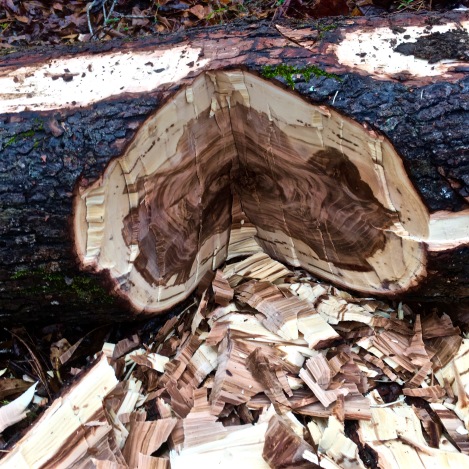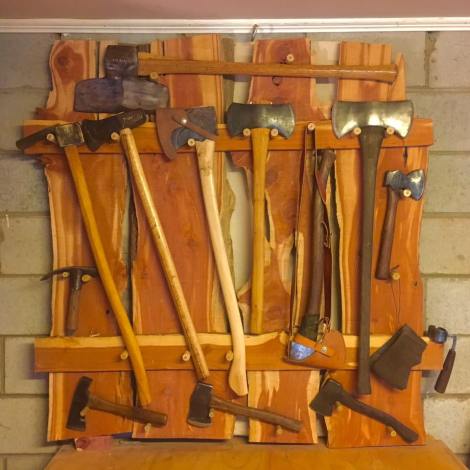by Todd Walker
I’m not sure when the bastardization began. But, make no mistake, it’s happened.
From a distance, there was an aura about the young man, he looked as though he had just stepped out of a 19th century lumber camp photo, like a man who knew the secrets of ax work and living off the land. The beard, plaid flannel (red and black of course), skinny britches rolled up a few turns to show off his vintage L.L. Bean boots with just a hint of wool sock protruding at the top. I imagined the aroma of wood smoke from his stack of flapjacks and coffee would hit me as I pushed DRG’s shopping cart past him on the frozen food aisle. Nope. Just another fashion-fabulous hipster.
A lot of my authentic southern readers may have never heard of this crossbred, the lumber-sexual. My Publix sighting confirms they’re here and not going anywhere no time soon. They seem to have migrated from their native habitat up north, the over-priced Minnesota coffee shops. Apparently, the lumberjack look was a new twist for hipsters. Remember the rhinestone cowboy craze from the 70’s? Same thing. They are born from cross-breeding a metrosexual and urban hipster (google these terms to get up to speed). The closest they’ve come to chopping a tree was the cutting of the Yule log at the office Christmas party. I guess the look and feel of simple lumber attire conjures up nostalgia, and, presumably, a boost in manliness.
I get it, chic clothing trends, like chiggers in a Georgia summer, never cease. A hipster sipping a passion tango herbal tea on a leather sofa at the corner coffee shop posing as a lumberjack seems non-congruent in my mind. I’ll give ’em one thing, they can buy an authentic lumber-look, even earth scented beard balm, but, to their chagrin, they can’t buy callouses. Those come by doing the stuff old lumberjacks did.
For the lumber sexual who stumbles upon this article, and feels the need to stop playing dress up, and would like to add authentic skills to match his attire, learn the art and lore of ax work. That wall-mounted ax over your headboard longs to feel its hickory handle whist through crisp air, hear metal separate wood fibers, and watch dinner plate size wood chips fling loose. This alone will assuredly add authenticity to your next filtered Instagram ax-selfie. An added bonus… the calloused handshake over a craft beer reeks of masculinity… adding to your woods cred.

No worries. Fixin’ Wax helps.
This guide may also be useful for the non-lumber sexual…
Authentic Ax Work (Not AXE Grooming Products)
Outside of fire, little else can contribute more to living comfortably in the wilderness than knowing how to properly use a well-chosen axe.
~ Mors Kochanski, Bushcraft, 1988
The ax is the oldest, most under-appreciated, yet invaluable tool which serves not only as a wilderness lifeline, but a simple machine that connects your hands to the forgotten craft of ax work. You’ll need an authentic ax to get starter. Don’t waste your money on box store axes. Once in my life, only once, I traded a Benjamin and some change for a Swedish ax just because of their reputation of forging fine steel. I was not disappointed.
A more budget friendly way, my preferred path, is vintage American made axes. Forgotten and left to rust in the corner of grandpa’s shed, these old treasures are waiting to be born again and eat wood.
For more guidance on choosing an ax, check out our article here.
How to Swing an Ax
All ax swings are inherently dangerous. Some are safer than others. But that’s part of the lure of ax work. Learning to reduce the risk of maiming (or worse) is your first priority.
It may not seem obvious, but the very first step, before your first swing in the woods, is to clear every vine, twig, overhead limb, camera man, and pet away from the area of your ax arc. The smallest thing can snag the ax on both backswing and forward chop. Look up and down the tree you plan to chop for any dead limbs. These hangers earned the name widow-maker for a reason. Even a small limb plummeting from 30 feet can crack your skull or destroy a shoulder. I know of a dead pine with a trunk split cradling a wrist-size limb in the crotch, tempting me to sink my felling ax into its trunk, but I resist, hoping and waiting for a gust of wind to bring it down. My gut tells me three thuds of my ax and DRG may be a widow. Follow your gut. Wise axmen strike the tree with the poll of their ax to loosen any potential hangers. Be prepared to drop the ax and follow exit routes you’ve cleared beforehand.
Ideally, you want level ground to plant your feet for chopping. That’s not always possible. If you’re new to ax work, find level ground free of tripping and slipping hazards and sink those vintage Danner boots in firmly.
For right-handers like me, grip the end of the handle with your left hand and your right hand on top of the left. Reverse this arrangement for southpaw. As you were taught in little league baseball, do not cross your wrists, right on bottom and left on top for right-handers, on swings. Coach Melvin told me this would break my wrists.
There are two basic ax swings: lateral and vertical. Certain guidelines should be followed for each swing.
Lateral Chopping
Lateral swings (diagonal and horizontal) are used to fell a tree, cut saplings in one swoop, and finish chops to separate a log while bucking. Any strokes outside your frontal zone is considered lateral swings. What’s your frontal zone?
In The Ax Book, which I recommend you devour until the pages are dog-eared, Dudley Cook describes the frontal zone as two parallel lines running along side the outside edges of your feet when chopping. All lateral swings should be outside the parallel lines, always. A miss hit or deflection from a full, extended-arm swing only stops when it strikes a target. Inertia forces the ax head to a stopping point, and that point could be your body if you disregard the frontal zone guidelines.
There are too many additional considerations such as, proper notching (face and back cuts), lean and lay, hang-ups, kick-backs, which can’t be covered in this one article, which is already a long but value-adding read, for you to safely chop down your first tree. I plan to write more on the subject later. Until then, read The Ax Book and watch more videos in the additional resources listed below.
With that being said, we will concentrate on ax swings which require wielding sharp steel within the frontal zone (toward your feet).
Vertical Chopping
Since the chainsaw removed the ax from most wood cutting, splitting firewood is by far the most used vertical swing presently. But, wanting to add authenticity to your life, there are other vertical strokes you should master.
Vertical chops fall into three categories…
- Backed up
- Non-backed, and
- Bucking, or chopping below the level of your feet
Backed Up
Backed up strokes are performed on another piece of robust wood (chopping block) wide enough to stop the ax swing momentum once it cuts through the target. The shorter the ax handle, the more dangerous the ax. The popular “boys ax” measures from armpit to finger length and makes a great all-purpose tool. However, care should be taken to understand that missing your target on vertical strokes with a shorter handle will likely bury the ax in your lower extremities. Keep the ax parallel to the ground at impact by bending your knees and waist during the downward stroke. This shortens your body and will likely sink the axhead in the chopping block, not your leg.
When chopping wrist-size green wood for your firewood pile, I’ve found this methods effective. Hold one end of the stick (about as long as you are tall) with your left hand and lay the other on a chopping block (backed-up stroke) with a notch or saddle on the edge of the stump. Accurately strike the stick where it rests in the notch at a 45 degree angle. Continue feeding the stick through the saddle notch until the last stove-length piece is left in your left hand. The angled cut should never be perpendicular to the stick. If struck too close towards your body, missing the saddle notch, the cut end will fly back toward your face like a wooden missile.
Steven Edholm has a great video demonstrating this technique on his channel, Skill Cult. He captures the wooden missile moment.
Another method, which I’m building at base camp now, is the Chopping Platform described by Mr. Cook. I’ll post the project once it’s complete.
Non-Backed Chops
Of all the vertical swings, this one possesses the most potential for injury. This stoke is not for a novice. Even experienced woodsmen make this cut only when other options are unavailable.
There may be an overhead limb which needs cutting. The safest way would be to saw the limb. However, an ax can be used with these precautions. Strike the limb with a modified grip by sliding your right hand half way up the ax handle to gain more control of the ax should it slice trough the limb. Strike at a 45 degree angle using only enough force to cut a portion of the limb’s diameter. Remember Newton’s first Law of Motion? An object (your ax) will keep moving until acted up by another force to stop its motion. Don’t let that other force be your body.
Do this ax stuff enough and you’ll encounter the bent sapling. I felled a broken Sweet Gum tree for the upcoming Chopping Platform project. In the limbing (de-limbing) video below, I demonstrate how to relieve tension with a non-backed, properly place ax stroke. Cutting a spring-loaded sapling near the ground unleashes unbelievable tension stored in the tree. If cut through, the potential energy converts to kinetic energy, and will not only mess up a well-groomed beard, but kill with a throat punch or head shot.
Bucking
Any wood large enough to stand on is fair game. The ax swing is safely backed up by the log being chopped as long the stroke stays below the level of your feet.
Again, clear all obstacles from the arc of your bucking swing. Hew two flat surfaces on either side of the cut line at the top of the horizontal log giving you a solid platform for your feet. If the log is on the ground and rocks while standing on top, step off and secure it by driving wooden wedges under each side for stabilization. Mark the width of your V notch with your ax on the side of the log to match its diameter.
I’ve used two methods to buck logs. First is to make a small V notch and widen it gradually to the desired width and halfway through the log. In my experience, I find the second method, described below, a more effective bucking technique.
Stand on top of the fallen tree and begin cutting a small (2-3 inch wide) V notch on the first mark with controlled strokes. This notch serves as the side cut for the larger notch. Now begin chopping the other mark at about a 45 degree angle. Use a pattern of overlapping cuts on the full length of the second mark (bottom to top). You should begin to loosen large wood chips from the entire notch at this point. Repeat this chopping pattern on each side of the notch to about halfway through the log.
Turn 180 degrees and face the other side of the log to repeat the same pattern. Ideally, you want the point of the two V notches to meet a hair off-center in the middle. When the log is close to separation, step to one side of the notch, the one securely supported, and separate the log with a few well placed strokes.
To cut closer to the bottom of the log, bend your back and waist and swing with fully extended arms. Chopping closer to the top of the log requires that you straighten your back but maintain extended arms on full swings. Do not choke up on the ax handle to make cuts at the top of the log. Pay attention to fatigue and rest as necessary.
For accurate downward strokes, swing the ax in line with your nose as you look at your target. Ax control and accuracy will develop with practice.
For the lumber sexual, authentic fashion is job one. Hijacking the ax, the lumber attire, and the beard on Instagram will develop neither the skills nor the callouses of lumberjacks. To be completely honest, I really couldn’t give a warm spittoon of tobacco juice that you look like an authentic lumberjack. You may have bought the look, complete with an expensive ax, but you can’t buy old skills. So grab an ax – chop, chop. And no, you can’t borrow mine…
You may loan your last dollar to a friend; but never loan him your axe, unless you are certain that he knows how to use it.
~ Horace Kephart, Camping and Woodcraft
Ax Work Resources:
- The Ax Book, D. Cook
- Bushcraft, Mors Kochanski
- Skill Cult, Steven Edholm’s YouTube Channel – Axe Cordwood Challenge (Hardcore ax work to chop a cord of wood with only an ax)
- An Ax to Grind, free PDF by Bernie Weisgerber, U.S. Forest Service
- Camping and Woodcraft, Horace Kephart
Keep Doing the Stuff of Self-Reliance,
Todd
P.S. – You can also keep up with the Stuff we’re Doing on Twitter, Pinterest, Google +, YouTube, Instagram, and Facebook… and over at our Doing the Stuff Network.
P.P.S – If you find value in our blog, Dirt Road Girl and I would appreciate your vote on Top Prepper Sites! You can vote daily by clicking here or on the image below. Check out all the other value-adding sites while you’re there…
Thanks for Sharing the Stuff!
Copyright © by Survival Sherpa: In light of the recent theft of all my content by a pirate site, my sharing policy has changed. I do not permit the re-posting of entire articles from my site without express written consent by me. My content on this site may be shared in digital form (200 words or less) for non-commercial use with a link back (without no-follow attribute) to the original article crediting the author. All photos, drawings, and articles are copyrighted by and the property of Survival Sherpa. You are more than welcome to share our photos and articles on social media for educational purposes as long as you link back to the original article/photo with credit to the author.














Wow! Amazing. And some of your article sounds like pure poetry! I don’t think i ever read a love poem to an ax, although i have heard a song about taking an ax to life (you know, going/coming at life with high energy and deliberate determination to succeed).
Oh wait! Years ago I wrote a story about an ax killer – Still have it, should pull it out.
What about girls and callouses? When i was working out, i used to get callouses when i used the overhead bar to do ‘never-completed but always a little better/higher’ chin-ups.
Thanks for your brilliant blog. i love it! I always vote for it. Sincerely,
On Thu, Jan 26, 2017 at 7:21 AM, Survival Sherpa wrote:
> Survival Sherpa posted: “by Todd Walker I’m not sure when the > bastardization began. But, make no mistake, it’s happened. From a distance, > there was an aura about the young man, he looked as though he had just > stepped out of a 19th century lumber camp photo, like a man w” >
LikeLike
Somehow missed your comment, ma’am. Many thanks for the kind words and following along here! And, yeah, callouses are good even on a lady 🙂
LikeLike
Perfect, absolutely precious. Looks like the only way to get some men to be a proper woodsman is to challenge his masculinity. Of course there will be some who are happy to be posers. I am neither a man or probably even strong enough to do said axe work but I will nonetheless study this article. One never knows when they might need to know this. Ps, a real man also sports a worn carhart type jacket with tatters and frays on the sleeves, worn jeans or other outdoor attire, rarely ever a newly bought ‘outfit’ only if one piece is new among the well worn pieces. I have to spread this story. The posers will be offended and the authentic will have a good laugh.
LikeLike
Haha, sure appreciate your input and support! Keep doing the stuff, friend!
LikeLike
HA!HA!HA! There is a Good One-the lumber sexual? You can look the role, but it won.t take five minutes to see “work callus”. They can pick up the axe and learn as you say. Worked timber industry and
woods thirty-years Pacific Nw. Started green too, 1969. OUCH!
LikeLike
And I’m sure you earned every callus and lesson over the years. I’d love to share a fire with you hear the stories.
LikeLike
Good tips on limbing, especially the choking up for controlled partial swings. I’ve been trying to explain that too and how you have to humble yourself to the work and take weak little swings to peck your way through stuff sometimes for safety’s sake, even though you could cut it in one hard swing. Axe work requires constant vigilance and adaptation. Here’s what I think of lumbersexuals ha ha. https://www.instagram.com/p/BPRKdwchDw8/?taken-by=skillcult
LikeLike
Thanks, man. I know, I saw that on IG 🙂 Keep wearing that plaid, bud, and teaching. Lots of value in your content!
LikeLike
Please stop the emails.
On Thu, Jan 26, 2017 at 7:21 AM, Survival Sherpa wrote:
> Survival Sherpa posted: “by Todd Walker I’m not sure when the > bastardization began. But, make no mistake, it’s happened. From a distance, > there was an aura about the young man, he looked as though he had just > stepped out of a 19th century lumber camp photo, like a man w” >
LikeLike
Hi Peggy, an email goes out to all who have subscribed to our site with every post we make. That is only about once a week or so. You can unsubscribe/un-follow if you like. Take care,
~ Todd
LikeLike
Pingback: Build a Chopping Platform to Safely Cut Firewood to Length with an Ax | Survival Sherpa
Pingback: Build a Chopping Platform to Safely Cut Firewood to Length with an Ax | Survival Sherpa
Pingback: 2 Ax Techniques for Fast Firewood Splitting | Survival Sherpa
Pingback: How to Hone Ax Skills and Chop Your Way to Functional Fitness | Survival Sherpa
Pingback: Logs to Lumber: Hand-Hewn Timber the Old Way | Survival Sherpa
Pingback: A Tenderfoot’s Guide to Chopping Firewood at Camp | Survival Sherpa
Pingback: Dirt Poor Floor Joists for an Off Grid Log Cabin | Survival Sherpa